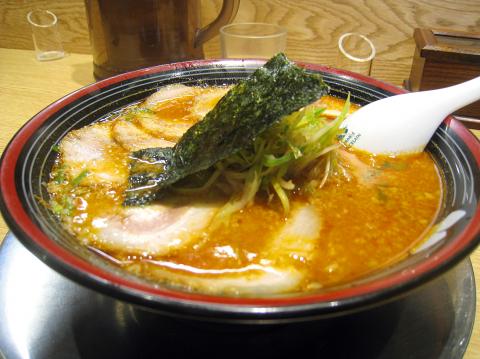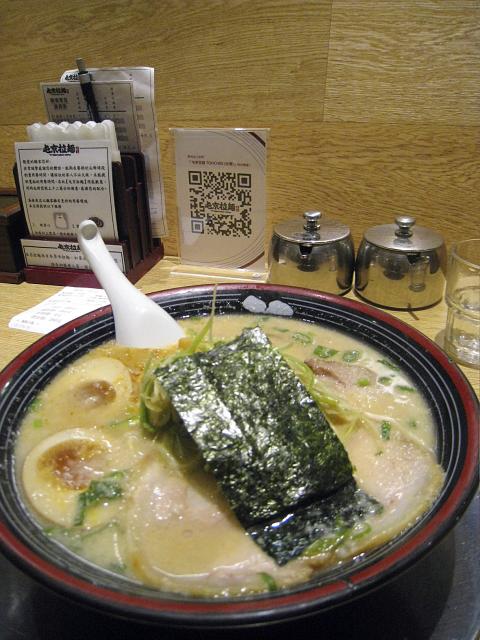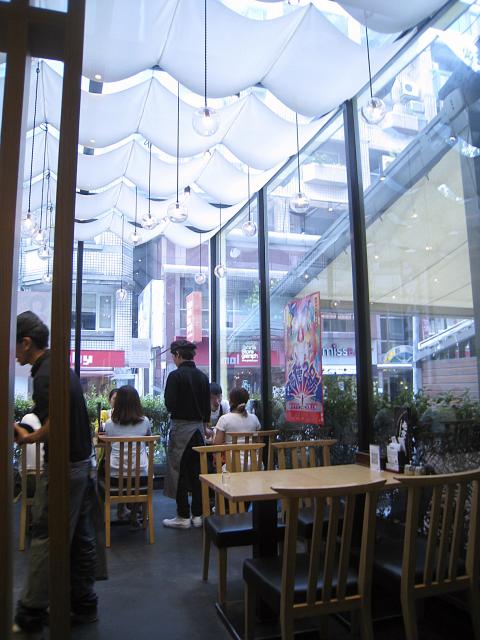Yet another foray in the ramen invasion of Taipei, Tonchin Ramen (屯京拉麵) purports to provide authentic ramen not just from Tokyo, but from the Ikebukuro district of that city.
Ikebukuro is a commercial and entertainment district, and the ramen that Tonchin serves up is quite a performance. I had been told that it was the polar opposite of Enishi Ramen (麵屋緣, reviewed in the Taipei Times on July 20, p12), which serves Kyoto style ramen, and that it would be hard to find two establishments serving the same food with such different presentation and ambiance.
Whereas Enishi is stripped down and understated, Tonchin has a big, high-ceilinged glass dining area, a slate-tiled stairway, a roped-off entry and exit lanes to manage the press of people. Although already an established presence, a lunchtime visit had a queue running down to the street.

Photo: Ian Bartholomew, Taipei Times
Despite the crowds, the service was efficient, and those waiting in line in the blistering summer heat were handed glasses of chilled water and paper fans to make the wait more bearable. A subsequent afternoon visit just after 4pm proved that Tonchin could remain three-quarters full even at this unfashionable time.
There is a huge picture menu that offers a wide number of variations on what is actually quite a small number of main dishes. The menu is an explosion of color, and it is easy to become overwhelmed by what seems a multitude of choice.
Exploration of what was on offer began with the super-value Tokyo-style pork ramen (NT$260), which packed an amazing amount of flavor and texture into a single bowl. There was sliced pork, preserved bamboo shoots, a chiffonade of spring onions, two egg halves, kombu and probably much more that could not be sorted from the ostentatious pile atop the bowl. Then there are the noodles, which are made with the unusual inclusion of fish powder into the dough, giving the strands a depth of flavor independent of the broth. This broth was also rich in flavor, with multiple layers revealing themselves as you got to grips with the dish. Screens above the service counter showed a short video about the making of the noodles and the broth, and highlighted the ceaseless crowds that cram Tonchin’s Tokyo outlets night and day.

Photo: Ian Bartholomew, Taipei Times
The super-value Tokyo-style pork ramen was good, but it was nothing you would write home about. It ticked all the right boxes for variety of flavor and texture, but there are other places in town that could meet it point for point.
The spicy Tokyo-style broth with caramelized onions (NT$260) was quite a different proposition, and had the kind of impact, if you like spicy food, that gets people coming back for second and third visits. The secret is that it is not super spicy, but generates a gentle slow burn in the gullet that seems particularly soothing in the hot weather. Ordered in the version with additional roast pork (NT$270), it is a meaty, fishy, spicy, salty, bowl of ramen heaven. Well-chilled water is available on the service counter, helping to wash down the heavily-flavored dish.
Servers ask whether you want a medium or large portion of noodles when you order. (Both are the same price.) Portions are generous and a medium serving is probably sufficient for all but the heartiest eaters.

Photo: Ian Bartholomew, Taipei Times
Servers also warn that the restaurant will not do takeout for unfinished noodle dishes.
A number of side dishes are available, ranging from cold tofu to western-style salads (NT$80), but none looked particularly appealing. Almost irresistible though were the deep-fried chicken pieces (NT$180), which are incredibly crunchy and moist, and almost worth the high price, and together with a bowl of noodles, make a blowout meal for one.
As the ramen invasion continues, Tonchin looks like it has already established its beachhead. Get in early or be prepared to wait in line.

June 23 to June 29 After capturing the walled city of Hsinchu on June 22, 1895, the Japanese hoped to quickly push south and seize control of Taiwan’s entire west coast — but their advance was stalled for more than a month. Not only did local Hakka fighters continue to cause them headaches, resistance forces even attempted to retake the city three times. “We had planned to occupy Anping (Tainan) and Takao (Kaohsiung) as soon as possible, but ever since we took Hsinchu, nearby bandits proclaiming to be ‘righteous people’ (義民) have been destroying train tracks and electrical cables, and gathering in villages

Dr. Y. Tony Yang, Associate Dean of Health Policy and Population Science at George Washington University, argued last week in a piece for the Taipei Times about former president Ma Ying-jeou (馬英九) leading a student delegation to the People’s Republic of China (PRC) that, “The real question is not whether Ma’s visit helps or hurts Taiwan — it is why Taiwan lacks a sophisticated, multi-track approach to one of the most complex geopolitical relationships in the world” (“Ma’s Visit, DPP’s Blind Spot,” June 18, page 8). Yang contends that the Democratic Progressive Party (DPP) has a blind spot: “By treating any

This year will go down in the history books. Taiwan faces enormous turmoil and uncertainty in the coming months. Which political parties are in a good position to handle big changes? All of the main parties are beset with challenges. Taking stock, this column examined the Taiwan People’s Party (TPP) (“Huang Kuo-chang’s choking the life out of the TPP,” May 28, page 12), the Democratic Progressive Party (DPP) (“Challenges amid choppy waters for the DPP,” June 14, page 12) and the Chinese Nationalist Party (KMT) (“KMT struggles to seize opportunities as ‘interesting times’ loom,” June 20, page 11). Times like these can

Swooping low over the banks of a Nile River tributary, an aid flight run by retired American military officers released a stream of food-stuffed sacks over a town emptied by fighting in South Sudan, a country wracked by conflict. Last week’s air drop was the latest in a controversial development — private contracting firms led by former US intelligence officers and military veterans delivering aid to some of the world’s deadliest conflict zones, in operations organized with governments that are combatants in the conflicts. The moves are roiling the global aid community, which warns of a more militarized, politicized and profit-seeking trend